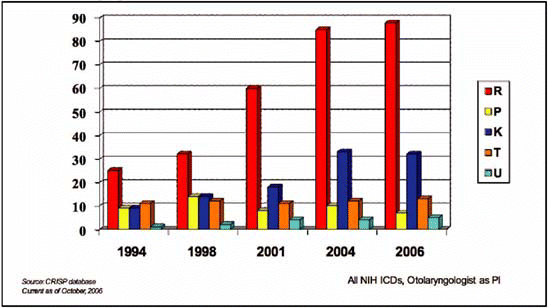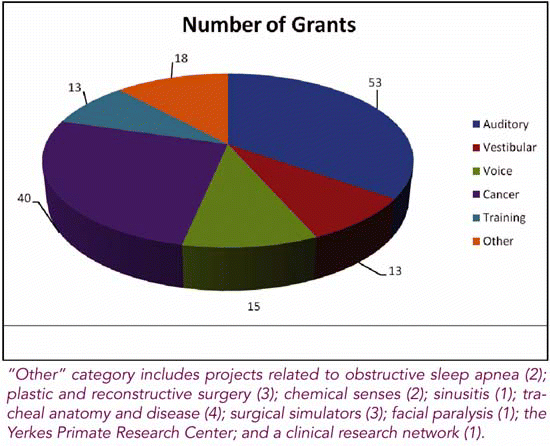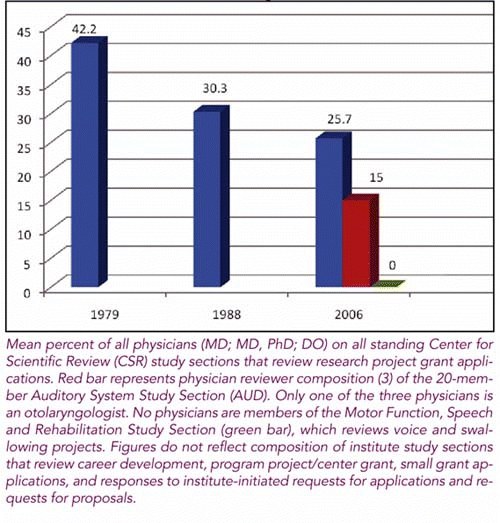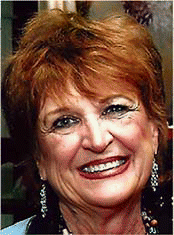Maureen Hannley, PhD, is currently Chief of the Research Division of the Department of Otolaryngology and Communication Sciences at Medical College of Wisconsin and Research Consultant for the Triological Society. She formerly served as the Chief Research Officer of the American Academy of Otolaryngology-Head and Neck Surgery Foundation and has held positions at the National Institutes of Health, Stanford University Medical School, and Arizona State University.
Explore This Issue
September 2007Part 2 of this article will discuss institutional support of research in otolaryngology-head and neck surgery and funding opportunities for researchers.
An important success story has been quietly taking place at the National Institutes of Health over the last decade, which bodes well for patient care, for science, and for the specialty. The number of funded projects with an otolaryngologist as the principal investigator has more than doubled between 1998 (74) and 2007 (152), as shown in Figure 1. The single largest increase has been in the number of research project grants (R mechanisms), followed by career development grants (K mechanisms); other types of funding have remained relatively stable.
Even as the number of R01s (research project grants) awarded to all physicians at NIH declined by 22% between 1998 and 2004, the number of R01s awarded to otolaryngologists in that same time period increased almost threefold. Furthermore, the growth of K grants is significant because it represents growing numbers of young investigators in the pipeline preparing themselves for careers as independent surgeon-scientists. At the institutional level, funding has increased from $36,818,272 to 37 departments in FY 1998 to $98,944,654 to 42 departments in FY 2005 (IMPAC database, www.nih.gov ); these figures include funding to all principal investigators with academic appointments in departments of otolaryngology, not limited to physicians. Funding is actually higher than that represented by these figures, as they reflect only academic departments of otolaryngology, not divisions, and do not include private institutions with active research programs such as Memorial Sloan-Kettering, House Ear Institute, Boys Town National Research Hospital, or Massachusetts Eye and Ear Infirmary; if the list were comprehensive, it would probably exceed $125 million.
Project Focus
The greatest numbers of projects (see Figure 2) are those investigating auditory structures, function, diseases, disorders, or treatments (34.9%). Of these, approximately 65% are using basic (bench) techniques to investigate otitis media, cholesteatoma, tinnitus, syndromic and nonsyndromic hearing impairment, and autoimmune, age-related, and viral-mediated inner ear disorders. The remaining 35% are clinical research projects, including long-term follow-up of cochlear implant patients, optimization strategies for implants, and several clinical trials. Research focused on vestibular or laryngeal functions make up another 18% of the grants.
More than a quarter of all funded otolaryngologists-head and neck surgeons are the principal investigators of projects related to head and neck cancer (28.3%). The cancer portfolio offers an impressive cross-section of projects, ranging from the molecular biology and molecular genetics of cancer to novel imaging techniques for early detection, margin analysis, immunotherapy and other treatment approaches, identification of treatment response markers and development of prediction models for disease progression, and long-term outcome databases. The 43 projects are supported almost equally by the National Institute of Dental and Craniofacial Research (NIDCR; 53.5%) and the National Cancer Institute (NCI; 46.5%); many otolaryngologists, however, have found that the NIDCR, which identifies head and neck cancer as one of its specific research mission areas, is a more advantageous venue for such applications than the NCI, where they must compete for funding with applications for the high-priority programs of breast, lung, and prostate cancer. Very little activity is focused on plastic and reconstructive surgery, although the areas of wound healing, tissue engineering, and craniofacial reconstruction and allotransplant science are currently high-emphasis areas related to the ongoing Middle Eastern war efforts-offering low-hanging fruit to the motivated surgeon-scientist with interests and skills in these areas.
The Investigators
As of March, 2007, 116 otolaryngologists-head and neck surgeons were principal investigators of 151 NIH grants, contracts, or cooperative agreements (CRISP database, www.nih.gov ); 21 of the total number (18.1%) are female. Approximately 36% of the 116 investigators are members of the Triological Society; their projects account for 41% of the total, and 48% of the research project (R series) grants. Twenty-five investigators have multiple grants and 12 (48%) of these are Triological Society members. The undisputed leader in this category is Jennifer Rubin-Grandis, MD, of the University of Pittsburgh, principal investigator on an impressive six grants, including two institutional training grants (T32s), a Specialized Program of Research Excellence (SPORE) in head and neck cancer, and three R01s. Other prolific investigators include Margaretha Casselbrant, MD, PhD; Saumil Merchant, MD; Jay Piccirillo, MD; David Sidransky, MD; and Richard Smith, MD, with three grants each.
It is not surprising that the institutions with the most funded otolaryngology projects align closely with the NIH rankings of total funding for departments of otolaryngology: Johns Hopkins University (11); University of Pittsburgh (10); Massachusetts Eye and Ear Infirmary (9); and Washington University at St. Louis (8). What is surprising-and a bit of a cause for concern-is the observation that only 18% of the grants have been in existence for more than five years, the duration of a career development or the maximum project period of a research project grant. To be fair, 26% of the 89 R series grants are accounted for by R03 (small grants) and R21 (exploratory grants), which are limited by definition to two to three years of funding, but which are designed to be steppingstones to broader, more extensive support such as that available through the R01 (independent research project grant).
Some seasoned investigators have found, however, that competition for funding is tougher than ever before: More applications of significantly higher quality are being submitted, and the average grant budget is more than 60% higher today than it was 10 years ago (IMPAC database, www.NIH.gov ); so even though the NIH’s budget doubled between 1998 and 2003, its buying power did not increase proportionately. Since 2003, the NIH budget appropriation has plateaued at essentially the same level, while research costs continue to rise. Moreover, with representation of physician reviewers on study sections at its lowest point in almost 30 years, otolaryngologists are often not at the table to serve as advocates for their peers’ medically oriented research projects (Figure 3). Other investigators are choosing to relinquish their grants without attempting to renew them in the face of escalating demands for clinical productivity in their academic departments, or the desire to carve out a more balanced lifestyle with family, friends, and free time.
The longevity record among the currently active research project grants belongs to Triological Society member Joseph B. Nadol Jr., MD, of the Massachusetts Eye and Ear Infirmary, for his project, Electron Microscopy of the Human Inner Ear, now in its 26th year of funding. His record is closely matched by Bruce Gantz, MD‘s cochlear implant program project grant (21 years), Richard Chole, MD, PhD‘s cholesteatoma project (19 years), and Dr. Richard T. Miyamoto, MD‘s two cochlear implant projects (16 and 18 years, respectively). An important national resource, the Yerkes National Primate Research Center, is supported by a specialized center grant now in its 46th year and is led by Michael M.E. Johns, MD, who was recently named Chancellor of Emory University.
Among the most durable of the grants are the institutional training grants (T32), the mainstay of research training for residents. Of the 13 institutional training grants led by otolaryngologists, 9 (69%) have been funded for 10 years or longer: University of Washington (24 years); University of Pittsburgh (21 years, 12 years); Washington University (20 years); Johns Hopkins University and Massachusetts Eye & Ear Infirmary (18 years each); University of Iowa and Memorial Sloan-Kettering (14 years each); and M. D. Anderson Cancer Center (10 years).
©2007 The Triological Society




Leave a Reply